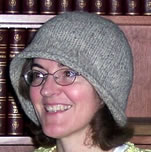
Hand Knit Bucket Hat
Hat completed Dec. 22, 2004.This page has a pattern generator (aka program) to create a pattern to help you knit a bucket hat by hand. The machine knit version is available here.
Main site, blog (read the latest), hat collection, and Poncho & Cape collection.
Characteristics of the hat:
- Knit from the hem to crown.
- You may vary the hat size to fit any head, and you may also vary the overall diameter of the hat.
- Felting is not required, but strongly recommended. I
pressed the excess roll out of the brim. If you knit this in acrylic,
and cannot press the hat, the brim will roll up. (I think that looks
cute, but it looks different from the one I'm wearing.)
- Has a small flared out brim.
To design your hat you will need to enter your head circumference and tightness factor below. You must also specify the stitch and row gauges.
Have fun knitting and wearing your hat,Lucia
Circular needles

Double pointed needles

Stitch markers

About 3 ounces of yarn. (More if you use chunky yarn.)